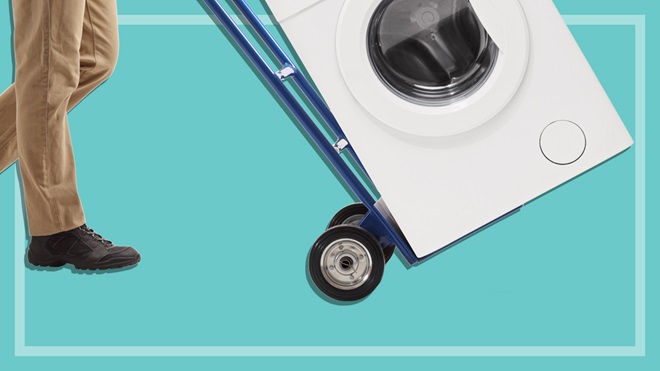Moving a washing machine can be a heavy and awkward task, so it's important to take proper precautions to avoid injury or damage to the machine. Here are some steps you can follow to move a washing machine safely.
Step-by-step guide for moving a washing machine
- First, gather all the necessary supplies, including a furniture or hand trolley (or strong and willing companion), straps or bungee cords, covers, wraps and gloves to protect your hands.
- Empty the washing machine of any clothes or other items.
- Drain any leftover water from the drainage area (see below for more).
- Disconnect the washing machine from the power outlet and the water supply (make sure they're both turned off before you do this).
- If your washing machine has a hose and cord, wrap them up and secure them with a bungee cord or tape.
- If your washing machine has a pedestal, remove it.
- If you still have transit bolts for a front loader, put them back into the rear of the machine so the internal drum doesn't swing about so much.
- Use the hand trolley to lift and move the washing machine. If you don't have a trolley, you can try lifting the washing machine with a partner, but be careful not to strain yourself.
- Once you have the washing machine on the trolley or in your hands, carefully move it to its new location.
- When you reach the new location, carefully lift the washing machine off the trolley or out of your hands and place it in its new spot.
- Reconnect the washing machine to the power outlet and water supply.
- Finally, double check that everything is properly connected and that the washing machine is stable before using it.
Why it's important to drain your washing machine
This isn't just a handy way to make the washing machine lighter when shifting it, it's also a safety issue. No one wants to slip on the water that's spilled from your washing machine. While it's impossible to get rid of all the water, you can minimise it.
Most front loaders have a waste area you can open to get rid of a lot of excess water, though not all of them do. In most cases it'll be in the bottom right-hand corner and you'll need to have some towels handy to wipe up any spills. The machine manual will have instructions on how to do this.
Top loaders are less easy to empty out from a compartment – instead you'll need to empty out from the waste hoses attached to the washing machine by laying them on the ground and letting gravity do the work. It's a bit messy but it's still relatively easy.
Transporting your washing machine
If you're planning on moving your washing machine in a car, make sure it's positioned against the bulkhead or back of the seats. This way you're unlikely to have a large metal object turn into a missile if you have a crash in transit.
Make sure you also use blankets to cushion the washing machine and protect car windows from damage. The type of car will matter, too – be careful closing the back of a hatchback to make sure you don't break the window if the washing machine is a little too far out.
We're on your side
For more than 60 years, we've been making a difference for Australian consumers. In that time, we've never taken ads or sponsorship.
Instead we're funded by members who value expert reviews and independent product testing.
With no self-interest behind our advice, you don't just buy smarter, you get the answers that you need.
You know without hesitation what's safe for you and your family. And our recent sunscreens test showed just how important it is to keep business claims in check.
So you'll never be alone when something goes wrong or a business treats you unfairly.
Learn more about CHOICE membership today
Stock images: Getty, unless otherwise stated.



